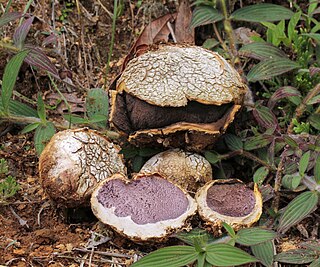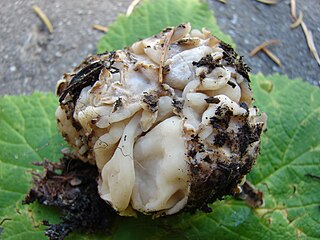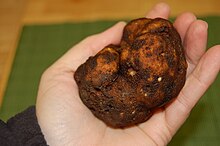
The Sclerodermataceae are a family of fungi in the order Boletales, containing several genera of unusual fungi that little resemble boletes. Taxa, which include species commonly known as the ‘hard-skinned puffballs’, ‘earthballs’, or 'earthstars', are widespread in both temperate and tropical regions. The best known members include the earthball Scleroderma citrinum, the dye fungus Pisolithus tinctorius and the 'prettymouths' of the genus Calostoma.

Scleroderma is a genus of fungi, commonly known as earth balls, now known to belong to the Boletales order, in suborder Sclerodermatineae. The best known species are S. citrinum and S. verrucosum. They are found worldwide. Various members of this genus are used as inoculation symbionts to colonize and promote the growth of tree seedlings in nurseries. They are not edible.

The Morchellaceae are a family of ascomycete fungi in the order Pezizales. According to a standard reference work, the family has contained at least 49 species distributed among four genera. However, in 2012, five genera that produce ascoma that are sequestrate and hypogeous were added. The best-known members are the highly regarded and commercially picked true morels of the genus Morchella, the thimble morels of the genus Verpa, and a genus of cup-shaped fungi Disciotis. The remaining four genera produce the sequestrate fruit bodies.

Calbovista is a fungal genus containing the single species Calbovista subsculpta, commonly known as the sculptured puffball, sculptured giant puffball, and warted giant puffball. It is a common puffball of the Rocky Mountains and Pacific Coast ranges of western North America. The puffball is more or less round with a diameter of up to 15 cm (6 in), white becoming brownish in age, and covered with shallow pyramid-shaped plates or scales. It fruits singly or in groups along roads and in open woods at high elevations, from summer to autumn.

Agaricus deserticola, commonly known as the gasteroid agaricus, is a species of fungus in the family Agaricaceae. Found only in southwestern and western North America, A. deserticola is adapted for growth in dry or semi-arid habitats. The fruit bodies are secotioid, meaning the spores are not forcibly discharged, and the cap does not fully expand. Unlike other Agaricus species, A. deserticola does not develop true gills, but rather a convoluted and networked system of spore-producing tissue called a gleba. When the partial veil breaks or pulls away from the stem or the cap splits radially, the blackish-brown gleba is exposed, which allows the spores to be dispersed.
Fevansia is a fungal genus in the family Albatrellaceae. A monotypic genus, it contains the single rare truffle-like species Fevansia aurantiaca, found in old-growth forests of Oregon. The name Fevansia honors Frank Evans of the North American Truffling Society, who collected the holotype specimen. Aurantiaca is Latin for "pale orange", referring to the color of the peridium.

Geopora cooperi, commonly known as the pine truffle or the fuzzy truffle, is a species of fungus in the family Pyronemataceae. It has a fuzzy brown outer surface and an inner surface of whitish, convoluted folds of tissue. Widely distributed in the Northern Hemisphere, the species has been recorded from Asia, Europe, and North America.

Leucangium is a genus of ascomycete fungi. The genus was circumscribed by French mycologist Lucien Quélet in 1883. Although classified in the Helvellaceae in the past, molecular analysis indicates it is closely related to the genus Fischerula and Imaia, and therefore must be placed in the Morchellaceae. The genus includes two species, Leucangium ophthalmosporum Quél. and L. carthusianum Paol., and both of them produce sequestrate ascoma, globose to ellipsoidal ascus, and dark olive-colored to grayish green, smooth, fusiform ascospores.

Cortinarius vanduzerensis is a species of mushroom in the family Cortinariaceae. Described as new to science in 1972, it is known only from the Pacific Northwest region of North America, where it grows under conifers such as spruce, hemlock, and Douglas-fir. The fruit bodies of the fungus, or mushrooms, have a slimy dark chestnut-brown cap that becomes deeply radially grooved or corrugated in maturity, and reaches diameters of up to 8 cm. The gills on the underside of the cap are initially pinkish-buff before becoming pale brown when the spores mature. The stem is lavender, measuring 10–18 cm (4–7 in) long and 1–2 cm thick. The mushroom produces a rusty-brown spore print, with individual spores measuring 12–14 by 7–8 micrometers. The edibility of the mushroom has not been determined, and it has been described as "much too slippery to be of value".

Tuber oregonense, commonly known as the Oregon white truffle, is a species of edible truffle in the genus Tuber. Described as new to science in 2010, the North American species is found on the western coast of the United States, from northern California to southern British Columbia west of the Cascade Range. A mycorrhizal fungus, it grows in a symbiotic association with Douglas fir. It overlaps in distribution with the closely related T. gibbosum, but they have different growing seasons: T. oregonense typically appears from October through March, while T. gibbosum grows from January to June. The fruit bodies of the fungus are roughly spherical to irregular in shape, and resemble small potatoes up to 5 cm (2 in) in diameter. Inside the truffle is the gleba, which is initially white before it becomes a marbled tan color. The large, often thick-walled, and strongly ornamented spores are produced in large spherical asci. The truffle is highly prized for its taste and aroma. Some individuals have claimed success in cultivating the truffles in Christmas tree farms.

Tuber lijiangense is a species of truffle in the family Tuberaceae. Found in China, it was described as a new species in 2011. Fresh truffles are pale yellow or light brown, roughly spherical, and measure up to 3 cm (1.2 in) in diameter.

Tuber microspermum is a species of truffle in the family Tuberaceae. Described as new to science in 2012, the edible species is found in China. The roughly spherical truffle is up to 1.5 cm (0.6 in) wide and yellowish-brown in color. It is distinguished from other truffles by its small asci and small spores that have a network-like surface pattern punctuated by small spines.

Tuber microspiculatum is a species of truffle in the family Tuberaceae. Found in China, it was described as new to science in 2012. The edible species has fruit bodies up to 2.5 cm (1.0 in) wide that range in color from light yellow to reddish brown depending on their age. It is distinguished microscopically from other similar truffles by the honeycomb-like ornamentation on the surface of its spores.

Tuber polyspermum is a species of truffle in the family Tuberaceae. Found in China, it was described as new to science in 2011. Fruit bodies of the truffle are small and brown, measuring up to 1.5 cm (0.6 in) in diameter.

Tuber sinoalbidum is a species of truffle in the family Tuberaceae. Known only from China, it was described as a new species in 2011. Fresh truffles are whitish with a similarly colored interior, and measure up to 4.5 cm (1.8 in) in diameter.

Tuber sinoexcavatum is a species of truffle in the family Tuberaceae. Described as a new species in 2011, it is found in China. The pale yellowish-brown to brown truffles measure up to 3 cm (1.2 in) in diameter. The species is named for its close resemblance to the common European truffle T. excavatum.

Scleroderma verrucosum is a basidiomycete fungus and a member of the genus Scleroderma, or "earth balls". First described scientifically in 1791, the species has a cosmopolitan distribution, and grows in the ground in nutrient-rich, sandy soils.
Imaia is a fungal genus in the family Morchellaceae found in Japan and in the Appalachian Mountains of the US.

Tuber donnagotto is a species of truffle in the family Tuberaceae. Described as a new species in 2012, it is found in Croatia. The black truffle measures 2–7 cm (0.8–2.8 in) in diameter.

Leucangium carthusianum is a species of ascomycete fungus. It is commonly known as the Oregon black truffle. It is found in the Pacific Northwest region of North America, where it grows in an ectomycorrhizal association with Douglas-fir. It is commercially collected, usually assisted by a specially trained truffle dog. Mature fruiting bodies can be dug up mostly during winter, but the season can extend from September through April.














